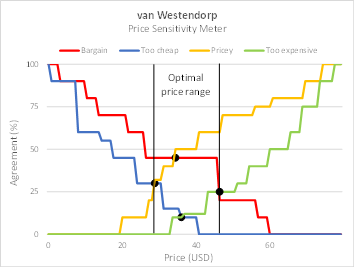The Price test confirms that it is not the price that sells the product. It is the value that makes the customer willing to pay.
Therefore, marketing research for pricing purposes should help to identify the price range that guarantees a level of margin and market share that maximizes long-term profitability.
So, in a Price test we do not ask the respondent “How much would you pay for [this product]?”.
Instead we test whether some price levels (found with financial analysis and intended to guarantee margin and profit) are compatible with the value our product offers.
In general, measuring price sensitivity differs on what is measured. There are two options:
-
- Intention. Intention to purchase is often tested with a survey.
- Purchases. This approach studies how customers make their purchases in either a controlled or uncontrolled test condition.
- Uncontrolled. It is about analyzing past sales data from different sources, such as Panel and/or Tracking studies, historical sales, store scanner data, online sales, and the like.
- Controlled. This test condition is typically executed in the form of in-store experiment, with real customers making real purchases either in a real store or in a lab setup reproducing a real store.
Try LogRatio’s fully automated solution for the professional analysis of survey data.
In just a few clicks LogRatio transforms raw survey data into all the survey tables and charts you need,
including a verbal interpretation of the survey results.
It is worth giving LogRatio a try!
How to measure prices
Over time, different approaches have been tested to measure the intention of customers to buy a product for a given price, each with its own advantages and limitations. Among popular methods:
-
- van Westendrop
- Gabor-Granger
- Conjoint analysis
van Westendorp Price Sensitivity Meter
The van Westendorp method known as the Price Sensitivity Meter (PSM) is a marketing research study concerning consumer price preferences.
It asks four questions of the kind “At what price would you consider [PRODUCT X] to be”:
-
- Too expensive to buy?
- Too cheap to believe?
- Starting to get expensive?
- A bargain?
The cumulated respondent answers shown in a chart cross each other in a way that forms the boundaries of the optimal price range.
The Optimal Price Range is supposed to include those price levels that satisfy the expectation of most customers.

Gabor-Granger method
The Gabor-Granger method helps in determining the price of a new product.
Survey respondents are queried sequentially to find out the highest price they are willing to pay. This is usually done by choosing 5 price levels and asking respondents their intent to buy for one of those 5 prices selected randomly.
The survey results consist of a demand curve and a revenue curve.
Conjoint analysis approach
The Conjoint analysis approach is applied to evaluate product features in combination with other features. Respondents are forced to make a choice of the desired features which are then used to compute the relative importance and to determine the optimal combinations. It can be used to predict market shares as well as price levels.
Several models have been developed, with the major approaches split between Preference-based and Choice-based methods.
The administration of the questionnaire and the analysis of the raw data require specialized software. Today, there are both desktop and online versions of tools useful to both gather and analyze the data of a Conjoint Analysis. The interpretation of results requires knowledge of the implications underlying this research methodology.
Sources
On the van Westendrop test: https://en.wikipedia.org/wiki/Van_Westendorp%27s_Price_Sensitivity_Meter
On the Gabor-Granger test: https://en.wikipedia.org/wiki/Gabor%E2%80%93Granger_method
On Conjoint analysis: James H. Myers, Gary M. Mullet, Managerial applications of multivariate analysis in marketing (2003). American Marketing Association.

